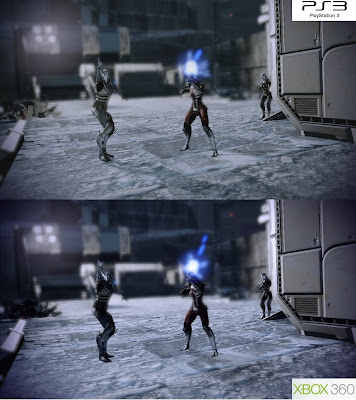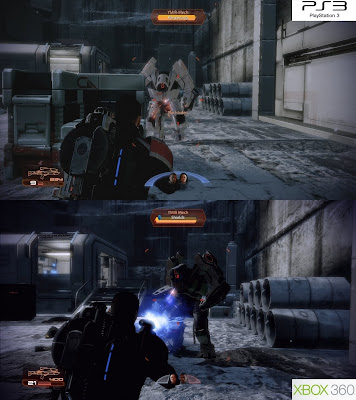For the most part, content found in game demos rarely feature any drastic improvements when sampling final retail code. However, with ME2 things are a little different. Bioware have tightened up the PS3 code, thus resulting in a few select optimisations that bring that build even closer to that of the Xbox 360 game.
While many of the somewhat subtle differences still remain, both performance and certain shader effects have been tangibly improved for the final PS3 release. But before we talk about those, lets quickly recap.

As expected, Mass Effect 2 renders in 720p across both formats, with the 360 game getting broken use of 2xMSAA and the PS3 having no AA at all. Due to the deffered nature of how the UE3 renders certain elements of the scene – it does so in separate render passes – much of the anti-aliasing in the 360 build is completely absent, with only a select few edges having the smoothing shade applied. In that respect, both versions look basically identical. In motion and in most screens, there’s nothing to tell them apart in this area.
In the demo, we described how the PS3 version of ME2 had some sacrifices made in order to work around the system’s well-documented memory constraints, along with improvements in other areas over the 360 game. Elements such as skin shaders and use of normal maps on the characters were both paired back, though we also saw the use of higher quality shadow filtering as well.
Looking at the retail build, and we see pretty much the same result, minus some small upgrades to the shader effects on Commander Shepard’s face along with higher res normal maps. The rest of the characters seem to be rendered exactly as before.

For the most part texture detail and filtering are largely identical as well. Here we see a few higher resolution texture maps on the characters in the PS3 game to compensate for the lack of normal mapping on some areas. Miranda’s hexagonal suit for one, lacks the normal mapped surface of the 360 game, but supplants this with clear use of higher res texturing. Occasionally, these changes make certain details appear a little flat, but mostly Bioware’s rebalancing of certain details works rather well.
Reduced levels of normal mapped textures on the environments are still present, as is the lack of HDR-styled bloom lighting. Although, we can also see that many environmental textures on both versions are simply hi-resolution ones, lacking normal maps and specular highlights. Instead, we have some diffuse reflection maps, along with the higher resolution artwork being used to compensate for the lack of depth normal mapping usually creates – depth is obtained in these cases via the texture maps themselves – in order to save on memory bandwidth on both systems.
There are also parts of the environment on the PS3 game that lack the same specular layer to represent sheen found on the 360 version when light passes over affected surfaces. This seems to be down to both an absence of the effect in addition to the lack of bloom. On some occasions, lighting composition in a scene often affects the amount of specularity that is present on certain surfaces. Although, it is also clear that some parts of the environment have the effect, while others obviously do not.

The lighting system found in the PS3 version of ME2 was perhaps the main talking point of the demo. In order to prepare for the upcoming, multiplatform release of Mass Effect 3, Bioware used an upgraded version of the UE3 for the PS3 build of ME2, resulting in a few noticeable differences in how lighting is handled across both versions of the game. But rather than being technically superior, or worse in any way, these differences seem to be more artistic in nature, with some scenes featuring more in the way of shadow detail, and others less so.
Outside of this change in overall composition, any oddities are likely to be a side-effect of the upgraded UE3’s lighting system not being completely compatible with the one used in the original PC and 360 versions of the game. And to that end, it's unlikely that Bioware had enough time to tweak thus any further, not with ME3 around the corner.
In any case, the reworked lighting engine in the PS3 game appears to be more ambient in nature, with less in the way of what looks like more direct light sources. Instead, characters and parts of the environment don’t always seem to be lit up according to specific object placement, but more inconspicuously throughout. Although, there are plenty of examples where this isn't the case, and in which the origin of the lighting is overly apparent.
As a result of this inconsistency, there are some shadowing errors present – characters that either look to dark, covered in shade, or too flat, lit up more strongly from various angles. We see this on both platforms, though at the expense of featuring lighting that looks a little out of place at times.
Both version display imperfections in this regard and, as to which one is the visually superior, technically better of the two. Well, that pretty much comes down to personal preference. Both implementations look great in general, with the PS3 game occasionally lacking depth in certain scenes and the 360 one over accentuating elements in others. The more subtle PS3 approach is more comfortable to look at overall - especially up close, and I do prefer it, but there’s nothing wrong with the 360’s lighting at all.
It will be interesting however, to see just how this part of the engine fares in the upcoming Mass Effect 3. Have Bioware opted for the PS3’s more ambient approach for the new game, or will we see the title displaying similar lighting properties to 360 ME2? If the lighting changes are equally artistically and tech based, then perhaps a better balance between the two will be found. We’ll just have to wait and see.

Now, in terms of performance, when first sampling the final retail copy of Mass Effect 2 compared to our demo findings, there were two things that we noticed; that the PS3 build no longer featured any screen tearing, and that the framerate appeared to never rise above 30fps. In fact, as a whole it looks like both versions are now basically almost equal in this regard, with generally more even levels of performance overall, but at the expense of the previously smoother jumps above the 30fps mark on the PS3.
What this means, is that the PS3 game is now v-synced across both gameplay and cut-scenes, and now also imposes a top end framerate cap at 30fps. As a result we see the lack of any screen tearing, but at the expense of having as much top-end smoothness on the whole. This varies between gameplay and cinematics, with the cut-scenes taking a prolonged dive down to 20fps on occasions where both systems cannot cope with the load provided by the engine.
Both initially appeared to be the same, although there are times when it looked like the PS3 game was dropping down to 20fps for ever so slightly longer periods.
Gameplay-wise, and we can see that the differences are much more pronounced. During the demo we sighted small up-shoots going beyond 30fps and into what looked like something around the 50-60fps mark. But in the final game, this isn’t the case. Like with the 360 version, ME2 on the PS3 starts off confidently running at 30fps, before dropping frames in heavier load situations – areas with multiple enemies and noticeable explotions all at once, as a good example.
Here we can see dips varying between what looks like 30 and 20fps, with both versions suffering in similar situations. However, the 360 game manages perform slightly better in an overall sense – both versions seem to suffer from slowdown, but seemingly at different points, whilst the PS3 tends to hold a reduced 20fps for slightly longer. In addition, both versions also slow down at different points: PS3 again tends to suffer slightly more, but also, we find that the engine is balancing different loads when this happens.
Compared to the demo, and we find that the PS3 build’s more stable, albeit slightly lowered framerate, is in fact preferable to the uncapped, 30fps plus refresh seen before. On the whole it simply feels smoother whilst also being a near like-for like match for the 360 game. In conclusion, performance is largely solid, with no unexpected drops beyond what we’ve already experienced before in 360 ME2. Some additional slowdown aside, Bioware have done a great job.

As we’ve already said before in our demo analysis, there are other factors besides graphics when considering which version of Mass Effect 2 to buy. Visually, both versions stack up rather nicely, with the subtle downgrades in normal mapping and shaders in the PS3 build having very little impact in the grand scheme of things. Also, the differing lighting implementations, which is the better of the two, is largely down to personal preference than technical superiority.
In that respect, the PS3 version of the game is perhaps equally as impressive as the 360 one, with other non-graphical features perhaps defining which game to go for. Take both content and pricing into account. The 360 game can be had for around £12 new in some places on the high street, £7 second hand, while the PS3 version retails for a full £40. Another thing to consider, is that the PS3 release comes with all of the DLC that came out last year over Xbox Live on the disc. Whereas, the 360 game is simply the bare bones original, but at a bargain price.
Ultimately, in terms of which version you should really go for, this will I expect, simply come down to whether or not you feel the extra money spent on the PS3 game is worth it over the saving of buying either a cheap copy of the 360 original. Personally, I think it might be, despite not being able to own all three games in the trilogy all on the same format. Either way, Mass Effect 2 is a superb experience and, the fact that owners of both system get to play it, is yet another bonus.
As ever, thanks go out to AlStrong (pixel counting) and to Videogamezone.de (screenshots). A full gallery of high quality shots can be found here.

ps3 win
ReplyDeleteBrimming with grand and virtuosic words.
ReplyDeletebest cell phone look up
Fantastic post, very informative. I wonder why the other specialists of this sector do not notice this. You must continue your writing. I'm confident, you have a great readers' base already!
ReplyDeleteโรงพิมพ์นนทบุรีa
Detailed and descriptive articles written in this blog is really very helpful for me as well as for other who seeking such kind of knowledge. It is definitely going to become useful in coming future.
ReplyDeleteแอร์ผ่อน
creativity of writer is purely impressive. It has touched to the level of expertise with his writing. Everything is up to the mark. Written perfectly and I can use such information for my coming assignment.
ReplyDeleteMetaTrader 5 คือ
This blog is so stunningly outstanding. Left its readers in the awe.
ReplyDeleteMason Soiza